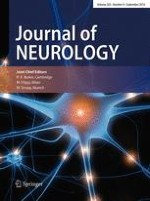Published in:

01-09-2016 | Original Communication
Effect of botulinum toxin treatment on quality of life in patients with isolated lingual dystonia and oromandibular dystonia affecting the tongue
Authors:
Laura Nastasi, Giovanni Mostile, Alessandra Nicoletti, Mario Zappia, Ester Reggio, Santiago Catania
Published in:
Journal of Neurology
|
Issue 9/2016
Login to get access
Abstract
The purpose of this study was to investigate the impact of botulinum toxin (BoNT) treatment on the quality of life (QoL) for patients with prominent lingual dystonia (LD) using a disease-specific questionnaire, the oromandibular dystonia questionnaire-25 (OMDQ-25). This is a prospective, observational study of a cohort of 30 patients treated with BoNT injections for LD, with or without concurrent jaw dystonia. Primary efficacy outcome was the absolute difference between total OMDQ-25 baseline score and total OMDQ-25 scores 4 and 8 weeks after the treatment. Safety outcome was the occurrence of adverse effects. The mean total OMDQ-25 baseline score was 46.8 ± 17.8. After BoNT treatment, there was a significant reduction in the mean total OMDQ-25 score at 4 weeks (38.2 ± 17.6; p = 0.004), as well as at 8 weeks (39.6 ± 18.1; p = 0.008). At the multiple regression analysis, a jaw deviation pattern (JDD) and high questionnaire baseline total score were detected as predictors of a better outcome, whilst associated jaw tremor was a predictor of poor outcome. In patients with JDD, jaw-opening muscles were more frequently injected and genioglossus less frequently than in patients without JDD. No major adverse events were detected. A consistent and measurable improvement in QoL, with good safety and tolerability, can be achieved in patients with prominent LD by injecting BoNT into genioglossus and/or other muscles of the oromandibular region.





